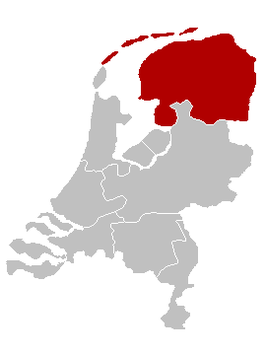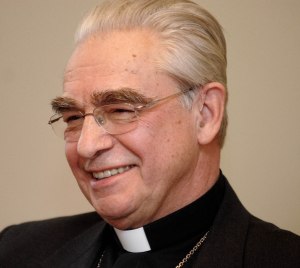On the threshold of 2017, a look ahead at what we may expect when it comes to the leadership of the various dioceses in Northwestern Europe.
 There have been years when the changes were rather significant, but 2017 does not look to be one of those. At the start of the new year, three dioceses are without a bishop: Groningen-Leeuwarden in the Netherlands (map at right), Mainz in Germany and the Territorial Prelature of Trondheim in Norway. It is a safe bet that the first two will receive their new bishops in 2017, but Trondheim may well be left as it has been for the past seven years: without a bishop, and with the bishop of Oslo serving as Apostolic Administrator. But on the other hand, for a see that just built and consecrated its new cathedral, and which, like the rest of Norway, has seen a significant increase in Catholic faithful, this does not seem like a situation that will continue forever. So who knows what the year will bring.
There have been years when the changes were rather significant, but 2017 does not look to be one of those. At the start of the new year, three dioceses are without a bishop: Groningen-Leeuwarden in the Netherlands (map at right), Mainz in Germany and the Territorial Prelature of Trondheim in Norway. It is a safe bet that the first two will receive their new bishops in 2017, but Trondheim may well be left as it has been for the past seven years: without a bishop, and with the bishop of Oslo serving as Apostolic Administrator. But on the other hand, for a see that just built and consecrated its new cathedral, and which, like the rest of Norway, has seen a significant increase in Catholic faithful, this does not seem like a situation that will continue forever. So who knows what the year will bring.
In Groningen-Leeuwarden, the new bishop will succeed Bishop Gerard de Korte, who was appointed to ‘s-Hertogenbosch in March. Almost ten months in, the vacancy is the longest for the Dutch Catholic Church in recent years. The new bishop of Mainz will follow in the footsteps of Cardinal Karl Lehmann, who led that ancient see for 33 years.
 There are a few bishops who will reach the age of 75 in 2017, and thus will offer their resignation. In Germany, these are Bishop Friedhelm Hofmann of Würzburg on 12 May and Norbert Trelle (at left) of Hildesheim on 5 September. Joining them is Bishop Frans Wiertz of Roermond in the Netherlands. He will be 75 on 2 December, but I would not be surprised if his retirement will be accepted earlier, as the bishop has been struggling with eye-related health problems.
There are a few bishops who will reach the age of 75 in 2017, and thus will offer their resignation. In Germany, these are Bishop Friedhelm Hofmann of Würzburg on 12 May and Norbert Trelle (at left) of Hildesheim on 5 September. Joining them is Bishop Frans Wiertz of Roermond in the Netherlands. He will be 75 on 2 December, but I would not be surprised if his retirement will be accepted earlier, as the bishop has been struggling with eye-related health problems.
There is one bishop serving past the age of 75. Bishop Luc Van Looy of Ghent has been asked to continue serving for another two years, so that Belgian see will remain occupied for the duration of 2017.
A less certain area to make predictions about is the appointment of auxiliary bishops. I expect, however, that two German dioceses will receive one auxiliary each. The Archdiocese of Hamburg has been without auxiliary bishops since October, when Bishop Hans-Jochen Jaschke retired. As the archdiocese is being reorganised, the number of auxiliary bishops will be decreased from two to one, and we may well see one of the three new area deans (representing the archdiocese’s constituent areas of Hamburg, Schleswig-Holstein and Mecklenburg) to be made a bishop. Further south, the Diocese of Münster has confirmed its request for a new auxiliary bishop after Heinrich Timmerevers was appointed to Dresden-Meißen in April. This will bring the number of auxiliary bishops back up to five, one for each pastoral area.
 In Rome, lastly, there will be no new consistory. Only four cardinals will reach the age of 80 and so cease to be electors. They are Audrys Backis, Archbishop emeritus of Vilnius, Lithuania (and former Nuncio to the Netherlands) (at right); Raymundo Damasceno Assis, Archbishop emeritus of Aparecida, Brazil; Attilio Nicora, Pontifical Legate to the Basilicas in Assisi, Italy; and Lluís Martínez Sistach, Archbishop emeritus of Barcelona, Spain. The number of cardinals who will be able to participate in a conclave will still be 116 at the end of next year, so there will be no need to bring their numbers up.
In Rome, lastly, there will be no new consistory. Only four cardinals will reach the age of 80 and so cease to be electors. They are Audrys Backis, Archbishop emeritus of Vilnius, Lithuania (and former Nuncio to the Netherlands) (at right); Raymundo Damasceno Assis, Archbishop emeritus of Aparecida, Brazil; Attilio Nicora, Pontifical Legate to the Basilicas in Assisi, Italy; and Lluís Martínez Sistach, Archbishop emeritus of Barcelona, Spain. The number of cardinals who will be able to participate in a conclave will still be 116 at the end of next year, so there will be no need to bring their numbers up.